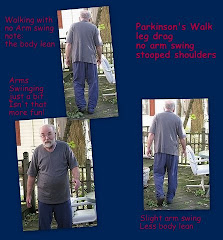It has the 2nd highest number of neurodegenerative disease patients; only Alzheimer's is higher. It is estimated that there are almost 1.5 million people who have PD in the US alone and more than 5.5 million globally. The numbers point to more men than women developing PD and to more whites with PD than Black Americans of African ancestry, Africans or Asians.
A rose by any other name
Parkinson's has also been called a prion disorder by Dr Stanley Prusiner because of the alpha synuclein pathology.
Historically
How will I know?
The tremors and actually most of the above precursor symptoms manifest because of chemical imbalances in the brain. Parkinson's is usually diagnosed after the death of about 60-80% of the dopamine neurons in the substantia nigra pars compacta of the basal ganglia. But before PD can actually develop a significant number of norepinephrine neurons must die also. As a precursor of norepinephrine, dopamine is the target area for PD treatment.
The predominant motor symptoms are defined by the acronym TRAP. Tremors, Rigidity, Akinesia (Bradykinesia) and Postural Instability all movement related.
What's Going On?
When the relax message cannot be sent as often, the rigidity and stiffness, the tremors and dyskinesias which typify PD, are seen. The stiffness can result in cramping and a little discussed symptom of Parkinson's known as pain. Usually treating the symptoms will relieve some of the physical pain.
Although the norepinephrine tries to take up some of the slack, there are fewer norepinephrine neurons in the brain to begin with and so with fewer precursor cells to make it, it too has been degenerating.
The why of dopamine cell death is being researched now and although there are some differences of opinion, it is thought that the cells die possibly when excess calcium in the cell causes the dopamine to leave the vesicle too early to be used and by hanging around in the cytosol it combines with alpha synuclein to become a gummy mess and ultimately die. Dopamine continues to die throughout the course of Parkinson's disease.
Despite the genetic research for PD, it is still called an idiopathic disease because the primary cause is unknown. There is YOPD, young onset PD and Juvenile Parkinson's both of which are felt to be predominantly genetic in origin.There are also other categories such as LBD or Lewy Body disorder which can occur before Parkinson's with parkinsonian symptoms developing later as well as PDD, Parkinson's disease with dementia in which the PD occurs first.
When the cause is genetic, Parkinson's can be autosomal dominant or autosomal recessive. There is no reason to cast blame as the genes can be hiding in the woodwork just waiting as the disease can skip generations.
We Are the World
PwPs around the world are generous in sharing their experiences with others. Support groups abound and fund raising never stops because so much funding is needed to support research for better treatments and cures.
There are signs everywhere
Tremors, slowness of movement (bradykinesia), stiffness and rigidity, swallowing and choking issues, change of voice, lack of facial expression, dyskinesia and dystonia (especially as a medication side effect) leg drag, lack of arm swing, urinary issues (such as incontinence, urinary frequency and urinary hesitancy) constipation, erectile dysfunction, dental problems, vision issues, loss of sense of smell, depression and apathy, hallucinations (usually a side effect of medications) dementia, cognition issues, drooling, breathing problems, postural instability, parkinsonian gait, freezing of motion, microphagia, change of skin condition (dry, oily) and the list goes on.
Symptoms and disease progression of the disease result in the inability of the patient to perform tasks of daily living and eventually unable to feed themselves or eat. The end stage symptoms can require feeding tubes and nursing homes.
One unusual feature of the disease is that many of the physical symptoms begin on one side of the body only, unilaterally. Tremors are usually resting tremors, meaning that the person is not initiating an action. As the disease progresses, the symptoms begin to appear bilaterally.
Can we make a difference?
What Parkinson's becomes is an insidious disease which can steal normal body function from people and replace it with huge expenses, create additional family stress and adjustment, subject people to public ignorance and ridicule. It is also amazing to know that it is a disease with a surprisingly low suicide rate, surprising when you consider that at least 40% of PwPs have PD depression. But it is also a disease of hope.
Although current medications and therapies help to relieve symptoms or slow progression, different people respond in different ways and much attention to detail is required by both patients and physicians. Patients and their caregivers learn to be their own best advocates, with special thanks to the printers attached to their computers.
Is there light at the end of this long tunnel?
2014 Addendum:
It is now known that there appear to be two types of Parkinson's disease. The first type is the one which we commonly identify with the disease and that is motor symptom predominant. The other type, the one in which medication should be initiated as soon as a diagnosis is made is non-motor symptom predominant PD. The latter can be a real fooler because the symptoms are subtle, easily attributable to other conditions.
We've all read the warnings about beginning L-dopa treatment early because the wearing-off times can begin often with even worse motor side effects, but in non-motor symptom predominant PD, there isn't a minute to spare.
At the time of the original posting of this article, this information simply was not available.





















Thanks so much for this overview - very helpful to me as my friend has just been diagnosed with PD.
ReplyDelete